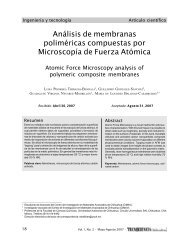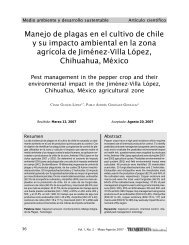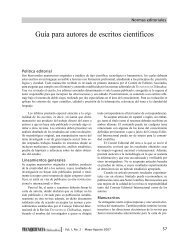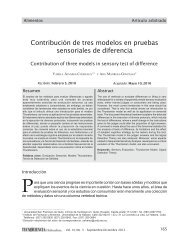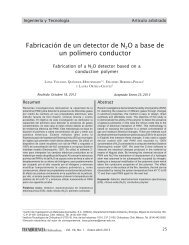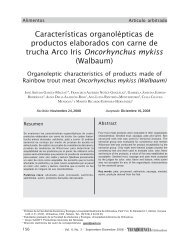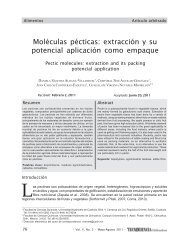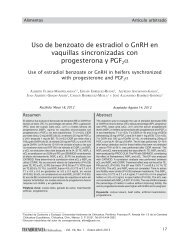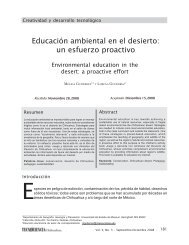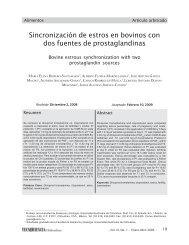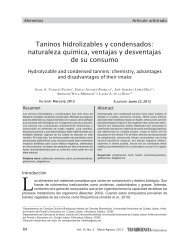Componentes de varianza de caracteres de maíz asociados al ...
Componentes de varianza de caracteres de maíz asociados al ...
Componentes de varianza de caracteres de maíz asociados al ...
You also want an ePaper? Increase the reach of your titles
YUMPU automatically turns print PDFs into web optimized ePapers that Google loves.
Alimentos<br />
Artículo arbitrado<br />
<strong>Componentes</strong> <strong>de</strong> <strong>varianza</strong> <strong>de</strong> <strong>caracteres</strong><br />
<strong>de</strong> <strong>maíz</strong> <strong>asociados</strong> <strong>al</strong> nixtam<strong>al</strong><br />
Components of variance of maize traits<br />
associated to nixtam<strong>al</strong><br />
JOSÉ SALAZAR-MARTÍNEZ 1,5 , AURELIO GUEVARA-ESCOBAR 2 , GUADALUPE MALDA-BARRERA 2 ,<br />
CÉSAR HUMBERTO RIVERA-FIGUEROA 3 Y YOLANDA SALINAS-MORENO 4<br />
Recibido: Mayo 4, 2009 Aceptado: Agosto 29, 2009<br />
Resumen<br />
Los componentes <strong>de</strong> <strong>varianza</strong> y la heredabilidad <strong>de</strong><br />
características <strong>de</strong> grano blanco, relacionadas con la c<strong>al</strong>idad<br />
industri<strong>al</strong> <strong>de</strong> la harina nixtam<strong>al</strong>izada, fueron estimadas en cinco<br />
híbridos <strong>de</strong> <strong>maíz</strong> (Zea mayz L.) <strong>de</strong>l tipo "media <strong>al</strong>tura". El objetivo<br />
<strong>de</strong>l trabajo fue conocer los componentes <strong>de</strong> <strong>varianza</strong>, la<br />
heredabilidad y la correlación <strong>de</strong> características <strong>de</strong> grano blanco<br />
asociadas con la c<strong>al</strong>idad industri<strong>al</strong> <strong>de</strong>l nixtam<strong>al</strong> <strong>de</strong> híbridos <strong>de</strong><br />
<strong>maíz</strong>. Durante el ciclo Verano 2003, se estableció el experimento<br />
bajo condiciones <strong>de</strong> riego en tres loc<strong>al</strong>ida<strong>de</strong>s representativas <strong>de</strong><br />
la región El Bajío. Se ev<strong>al</strong>uaron nueve características físicas <strong>de</strong><br />
grano y siete asociadas <strong>al</strong> proceso <strong>de</strong> "nixtam<strong>al</strong>ización". Se<br />
i<strong>de</strong>ntificaron cinco rasgos <strong>de</strong> interés para la industria <strong>de</strong>l nixtam<strong>al</strong>:<br />
Peso o masa hectolítrica (<strong>de</strong>nsidad <strong>de</strong> grano) y peso <strong>de</strong> 100<br />
granos, <strong>asociados</strong> <strong>al</strong> rendimiento <strong>de</strong> grano a tortilla; endospermo<br />
tipos harinoso y córneo, relacionados con la c<strong>al</strong>idad <strong>de</strong> la tortilla;<br />
pericarpio retenido, asociado <strong>al</strong> rendimiento <strong>de</strong> grano a tortilla.<br />
La variable pericarpio retenido mostró una heredabilidad <strong>al</strong>ta (h 2<br />
> 0.50), mientras que los <strong>caracteres</strong> peso hectolítrico, peso <strong>de</strong><br />
cien granos, endospermo harinoso y endospermo córneo<br />
presentaron baja heredabilidad (h 2 < 0.50). De acuerdo a los<br />
resultados observados en esta investigación, se recomienda<br />
seleccionar grano <strong>de</strong> <strong>maíz</strong> con v<strong>al</strong>ores <strong>de</strong> endospermo<br />
(porcentaje base seca <strong>de</strong>l grano) <strong>de</strong> tipo harinoso menor <strong>de</strong> 36.4<br />
%, tipo duro o córneo mayor <strong>de</strong> 46.4 %; a<strong>de</strong>más, el pericarpio<br />
retenido <strong>de</strong>bería ser mayor <strong>de</strong> 35.8 %.<br />
P<strong>al</strong>abras clave: <strong>Componentes</strong> <strong>de</strong> <strong>varianza</strong>, heredabilidad,<br />
coeficiente <strong>de</strong> variación genética, c<strong>al</strong>idad <strong>de</strong> nixtam<strong>al</strong>, pericarpio<br />
retenido<br />
Abstract<br />
Components of variance and heritability of white grain<br />
characteristics, related to industri<strong>al</strong> qu<strong>al</strong>ity of nixtam<strong>al</strong>ized corn<br />
flour, were estimated in five maize hybrids (Zea mayz L.) type<br />
"media <strong>al</strong>tura". The objective of this study was to know<br />
components of variance, heritability and correlation coeficients<br />
among grain traits associated to nixtam<strong>al</strong> qu<strong>al</strong>ity of white grain<br />
maize hybrid. During the Summer-2003 season, an experiment<br />
was established un<strong>de</strong>r irrigation conditions in three locations<br />
representative of the agriculture region "El Bajío". Nine physic<strong>al</strong><br />
characteristics of grain and seven more traits associated to<br />
corn "nixtam<strong>al</strong>ización" industri<strong>al</strong> process were ev<strong>al</strong>uated. Five<br />
important characteristics for "nixtam<strong>al</strong>" industry were i<strong>de</strong>ntified:<br />
Hectoliter weight (grain <strong>de</strong>nsity) and weight of 100 grains,<br />
associated to yield of grain to tortilla; endosperm corn types<br />
flour and hard, related to tortilla qu<strong>al</strong>ity; retained pericarp,<br />
associated to yield of grain to tortilla. The variable retained<br />
pericarp showed a high heritability (h 2 > 0.50), while for the<br />
characteristics: Hectoliter weight, weight of 100 grains,<br />
endosperm types flour and hard were the estimated heritability<br />
v<strong>al</strong>ues were lower than 0.50. According to the observed results,<br />
it is recommendable to select endosperm corn v<strong>al</strong>ues<br />
(percentage based on grain dry weight) type flour below 36.4<br />
%, type hard greater than 46.4 %; moreover, the retained<br />
pericarp should be above 35.8 %.<br />
Keywords: Components of variance, heritability, genetic<br />
variation coefficient, nixtam<strong>al</strong> qu<strong>al</strong>ity, retained pericarp<br />
_________________________________<br />
1<br />
Estudiante <strong>de</strong>l Programa <strong>de</strong> Doctorado, Facultad <strong>de</strong> Ciencias Natur<strong>al</strong>es-Biología. Universidad Autónoma <strong>de</strong> Querétaro. Centro<br />
Universitario s/n. Cerro <strong>de</strong> las Campanas. Querétaro, México. C. P. 76010. Teléfono: (442)192-1200, extensión 5371.<br />
2<br />
Profesor <strong>de</strong> la Facultad <strong>de</strong> Ciencias Natur<strong>al</strong>es-Biología. Universidad Autónoma <strong>de</strong> Querétaro. Centro Universitario s/n. Cerro <strong>de</strong> las<br />
Campanas. Querétaro, México. C. P. 76010. Teléfono: (442)192-1200, extensión 5371.<br />
3<br />
Jefe <strong>de</strong>l Departamento <strong>de</strong> Investigación, Dirección <strong>de</strong> Investigación y Posgrado. Universidad Autónoma <strong>de</strong> Chihuahua. Campus<br />
Universitario # 1, Chihuahua, Chihuahua. México. C. P. 31170. Teléfono: (614) 439-1822. FAX: (614) 439-1823.<br />
4<br />
Laboratorio <strong>de</strong> C<strong>al</strong>idad <strong>de</strong> Maíz, Instituto Nacion<strong>al</strong> <strong>de</strong> Investigaciones Forest<strong>al</strong>es, Agrícolas y Pecuarias (INIFAP). Campo Experiment<strong>al</strong><br />
"V<strong>al</strong>le <strong>de</strong> México". Apartado post<strong>al</strong> 10, Chapingo, Estado <strong>de</strong> México. México. C. P. 56230.<br />
5<br />
Dirección electrónica <strong>de</strong>l autor <strong>de</strong> correspon<strong>de</strong>ncia: mu_technology@yahoo.com.mx.<br />
74<br />
• Vol. III, No. 2 • Mayo-Agosto 2009 •
JOSÉ SALAZAR-MARTÍNEZ, AURELIO GUEVARA-ESCOBAR, GUADALUPE MALDA-BARRERA, CÉSAR HUMBERTO RIVERA-FIGUEROA Y YOLANDA<br />
SALINAS-MORENO: <strong>Componentes</strong> <strong>de</strong> <strong>varianza</strong> <strong>de</strong> <strong>caracteres</strong> <strong>de</strong> <strong>maíz</strong> <strong>asociados</strong> <strong>al</strong> nixtam<strong>al</strong><br />
EIntroducción<br />
l <strong>maíz</strong> (Zea mayz L.) representa uno <strong>de</strong> los cere<strong>al</strong>es <strong>de</strong> mayor importancia para la<br />
<strong>al</strong>imentación <strong>de</strong> la población latinoamericana; en México es el cultivo más importante y la<br />
princip<strong>al</strong> fuente <strong>de</strong> <strong>al</strong>imentos. Rosa et <strong>al</strong>. (2006) comentan que la producción anu<strong>al</strong> es <strong>de</strong><br />
18.2 millones <strong>de</strong> toneladas <strong>de</strong> <strong>maíz</strong> en una superficie <strong>de</strong> 8.5 millones <strong>de</strong> hectáreas, y que los<br />
híbridos <strong>de</strong> grano blanco representan 95 % <strong>de</strong>l tot<strong>al</strong> <strong>de</strong> híbridos, <strong>de</strong>stinados princip<strong>al</strong>mente para<br />
consumo humano.<br />
México posee la mayor diversidad<br />
genética <strong>de</strong> <strong>maíz</strong>, la cu<strong>al</strong> se manifiesta en<br />
variación <strong>de</strong> <strong>caracteres</strong> morfológicos<br />
vegetativos, así como <strong>de</strong> espiga, mazorca y<br />
grano, y en la composición química <strong>de</strong>l grano,<br />
<strong>de</strong> las 436 razas reportadas en el continente<br />
americano, 50 se encuentran en México<br />
(Goodmen y Brown, 1988). La mayor<br />
diversidad <strong>de</strong> razas, y varieda<strong>de</strong>s <strong>de</strong>l <strong>maíz</strong> que<br />
se concentran en México, han formado parte<br />
<strong>de</strong>l germoplasma con el que se han<br />
<strong>de</strong>sarrollado varieda<strong>de</strong>s <strong>de</strong> <strong>al</strong>to rendimiento y<br />
adaptabilidad, así como la producción <strong>de</strong><br />
híbridos para zonas <strong>de</strong> riego (Sánchez y<br />
Goodman, 1992).<br />
La mayor parte <strong>de</strong> la producción <strong>de</strong> grano<br />
proveniente <strong>de</strong> híbridos, se <strong>de</strong>stina<br />
princip<strong>al</strong>mente a la industria, mientras que el<br />
grano proveniente <strong>de</strong> las varieda<strong>de</strong>s criollas<br />
se <strong>de</strong>stina princip<strong>al</strong>mente <strong>al</strong> autoconsumo. La<br />
mayor superficie sembrada con híbridos <strong>de</strong><br />
<strong>maíz</strong> y varieda<strong>de</strong>s mejoradas se loc<strong>al</strong>iza en<br />
la Región <strong>de</strong>l Pacífico (clima tropic<strong>al</strong>),<br />
representada princip<strong>al</strong>mente por Sin<strong>al</strong>oa y El<br />
Bajío (clima templado), princip<strong>al</strong>mente en los<br />
estados <strong>de</strong> J<strong>al</strong>isco, Guanajuato y Querétaro<br />
(SFAB–Canacintra, 2002).<br />
En cuanto a la cantidad y formas <strong>de</strong><br />
consumo <strong>de</strong> grano <strong>de</strong> <strong>maíz</strong>, en México, por<br />
ejemplo, existe una gran diversidad <strong>de</strong><br />
productos nixtam<strong>al</strong>izados, que forman parte<br />
<strong>de</strong> la <strong>al</strong>imentación <strong>de</strong> la población, como<br />
tortilla, pinole, atole, tostada, tam<strong>al</strong> y elote; <strong>de</strong><br />
éstos, la tortilla constituye el princip<strong>al</strong> producto,<br />
cuyo consumo per cápita es <strong>de</strong> 328 g por día<br />
(Figueroa et <strong>al</strong>., 2001). Para mejorar la c<strong>al</strong>idad<br />
industri<strong>al</strong> <strong>de</strong>l grano <strong>de</strong> <strong>maíz</strong> es necesario el<br />
análisis <strong>de</strong> los parámetros físicos y químicos<br />
• Vol. III, No. 2 • Mayo-Agosto 2009 •<br />
<strong>de</strong>l grano, porque están estrechamente<br />
<strong>asociados</strong> con el proceso <strong>de</strong> elaboración <strong>de</strong><br />
productos nixtam<strong>al</strong>izados (S<strong>al</strong>inas y Arellano,<br />
1989). Un análisis <strong>de</strong>l proceso <strong>de</strong><br />
nixtam<strong>al</strong>ización y <strong>de</strong>l producto terminado, se<br />
enfoca en características como: pericarpio<br />
retenido, humedad <strong>de</strong>l nixtam<strong>al</strong>, pérdida <strong>de</strong><br />
sólidos, rendimiento <strong>de</strong> grano a masa y a tortilla,<br />
color <strong>de</strong> la masa y color <strong>de</strong> la tortilla.<br />
Dado que el ambiente, el genotipo, y la<br />
interacción entre ambos factores tienen<br />
influencia sobre las características <strong>de</strong> c<strong>al</strong>idad<br />
<strong>de</strong>l grano, es fundament<strong>al</strong> aprovechar la<br />
variabilidad genética disponible para elevar el<br />
rendimiento, mejorar la c<strong>al</strong>idad <strong>de</strong> grano y<br />
eficientizar el proceso <strong>de</strong> nixtam<strong>al</strong>ización<br />
(Ehdaie y Waines, 1989). Araújo et <strong>al</strong>. (2008)<br />
comentan que poco se conoce acerca <strong>de</strong> la<br />
heredabilidad <strong>de</strong> las características físicas y<br />
químicas <strong>de</strong>l grano <strong>de</strong> <strong>maíz</strong> que se<br />
correlacionan con la c<strong>al</strong>idad industri<strong>al</strong> <strong>de</strong>l<br />
nixtam<strong>al</strong>, y menos aún sobre el grado <strong>de</strong><br />
influencia que el ambiente ejerce sobre ellas.<br />
Arnhold, et <strong>al</strong>. (2006) estudiaron varios<br />
<strong>caracteres</strong> funcion<strong>al</strong>es en <strong>maíz</strong> p<strong>al</strong>omero,<br />
encontrando una correlación positiva entre<br />
capacidad <strong>de</strong> expansión <strong>de</strong>l grano y<br />
producción.<br />
El conocimiento <strong>de</strong> la heredabilidad <strong>de</strong> t<strong>al</strong>es<br />
características <strong>de</strong> grano y <strong>de</strong> sus correlaciones<br />
pue<strong>de</strong> ser útil en un programa <strong>de</strong> mejoramiento<br />
genético, mediante la selección simultánea <strong>de</strong><br />
dos o más rasgos y un manejo óptimo <strong>de</strong>l<br />
ambiente <strong>de</strong> cultivo (Espitia-Rangel et <strong>al</strong>., 2004).<br />
El presente trabajo tiene como objetivo conocer<br />
los componentes <strong>de</strong> <strong>varianza</strong>, la heredabilidad<br />
y la correlación <strong>de</strong> características <strong>de</strong> grano<br />
blanco asociadas con la c<strong>al</strong>idad industri<strong>al</strong> <strong>de</strong>l<br />
nixtam<strong>al</strong> <strong>de</strong> híbridos <strong>de</strong> <strong>maíz</strong>.<br />
75
JOSÉ SALAZAR-MARTÍNEZ, AURELIO GUEVARA-ESCOBAR, GUADALUPE MALDA-BARRERA, CÉSAR HUMBERTO RIVERA-FIGUEROA Y YOLANDA<br />
SALINAS-MORENO: <strong>Componentes</strong> <strong>de</strong> <strong>varianza</strong> <strong>de</strong> <strong>caracteres</strong> <strong>de</strong> <strong>maíz</strong> <strong>asociados</strong> <strong>al</strong> nixtam<strong>al</strong><br />
Materi<strong>al</strong>es y métodos<br />
Establecimiento <strong>de</strong>l experimento. Durante<br />
el ciclo primavera-verano <strong>de</strong> 2003, se comparó<br />
el comportamiento <strong>de</strong> cinco híbridos<br />
comerci<strong>al</strong>es <strong>de</strong> <strong>maíz</strong> <strong>de</strong> grano blanco, <strong>de</strong>l tipo<br />
<strong>de</strong>nominado «media <strong>al</strong>tura». Estos híbridos<br />
(Cuadro 1) son parci<strong>al</strong>mente representativos <strong>de</strong><br />
la variabilidad genética <strong>de</strong> la empresa Monsanto;<br />
mo<strong>de</strong>lo <strong>de</strong> «efecto fijo», dicha empresa es lí<strong>de</strong>r<br />
en mejoramiento genético <strong>de</strong> <strong>maíz</strong> y en la<br />
producción y comerci<strong>al</strong>ización <strong>de</strong> semilla<br />
híbrida, con un participación <strong>de</strong> mercado en<br />
México <strong>de</strong>l 65 %. Para ev<strong>al</strong>uar el efecto <strong>de</strong>l medio<br />
ambiente, se sembró en tres loc<strong>al</strong>ida<strong>de</strong>s: Pedro<br />
Escobedo (Querétaro), La Barca (J<strong>al</strong>isco) y<br />
Ciudad Guzmán (J<strong>al</strong>isco); ubicadas en El Bajío.<br />
Las condiciones <strong>de</strong> siembra se apegaron <strong>al</strong><br />
programa <strong>de</strong> ev<strong>al</strong>uación <strong>de</strong> híbridos <strong>de</strong> riego <strong>de</strong><br />
la compañía Monsanto.<br />
Cuadro 1. Características agronómicas <strong>de</strong> los híbridos<br />
<strong>de</strong> <strong>maíz</strong> <strong>de</strong> cruza triple<br />
Nombre<br />
<strong>de</strong>l<br />
híbrido<br />
D ías a floración Altura<br />
(cm)<br />
Masculina<br />
Femenina<br />
Planta<br />
Mazorca<br />
Mazorcas<br />
Promedio<br />
(%)<br />
Tipo <strong>de</strong><br />
grano<br />
León<br />
83<br />
85<br />
268<br />
115<br />
95-105<br />
Dentad o<br />
DK<br />
2002 86<br />
88<br />
253<br />
117<br />
95-105<br />
Dentad o<br />
Puma<br />
83<br />
84<br />
228<br />
115<br />
95-105<br />
Dentad o<br />
Tigre<br />
82<br />
84<br />
252<br />
112<br />
95-105<br />
Dentad o<br />
DK<br />
2000 73<br />
76<br />
243<br />
85<br />
95-105<br />
Dentad o<br />
Fuente: Datos proporcionados por el Dr. Manuel<br />
Oyervi<strong>de</strong>s <strong>de</strong> Monsanto Company<br />
Diseño experiment<strong>al</strong>. Se utilizó un diseño<br />
<strong>de</strong> bloques completos <strong>al</strong> azar en loc<strong>al</strong>ida<strong>de</strong>s<br />
(diseño combinado), en un arreglo <strong>de</strong><br />
tratamientos factori<strong>al</strong> 3 (ambientes) x 5<br />
(genotipos), con dos repeticiones por<br />
tratamiento. El factor A consistió en las tres<br />
loc<strong>al</strong>ida<strong>de</strong>s, mientras que el factor B estuvo<br />
representado por los cinco híbridos comerci<strong>al</strong>es.<br />
La parcela experiment<strong>al</strong> consistió en cuatro<br />
surcos <strong>de</strong> 6 m <strong>de</strong> largo, espaciados 100 cm y<br />
con una separación entre plantas <strong>de</strong> 12.5 cm,<br />
lo que representa una <strong>de</strong>nsidad <strong>de</strong> población <strong>de</strong><br />
aproximadamente 80,000 plantas por hectárea,<br />
un número <strong>de</strong> plantas ampliamente utilizado en<br />
El Bajío mexicano. Para la recolección <strong>de</strong><br />
muestras <strong>de</strong> grano y la toma <strong>de</strong> datos, se eligió<br />
como unidad <strong>de</strong> muestreo a los dos surcos<br />
centr<strong>al</strong>es, sin incluir las plantas <strong>de</strong> los<br />
extremos, para reducir el efecto <strong>de</strong> orilla, la<br />
muestra <strong>de</strong> grano <strong>al</strong> 14 % <strong>de</strong> humedad fue <strong>de</strong><br />
1.0 kg.<br />
Toma <strong>de</strong> datos y variables. Las<br />
<strong>de</strong>terminaciones y análisis <strong>de</strong> las<br />
características <strong>de</strong> c<strong>al</strong>idad <strong>de</strong>l grano se<br />
re<strong>al</strong>izaron en el Laboratorio <strong>de</strong> C<strong>al</strong>idad <strong>de</strong> Maíz<br />
<strong>de</strong>l Instituto Nacion<strong>al</strong> <strong>de</strong> Investigaciones<br />
Forest<strong>al</strong>es, Agrícolas y Pecuarias (INIFAP),<br />
ubicado en Texcoco, Estado <strong>de</strong> México.<br />
Caracterización física <strong>de</strong>l grano. Índice <strong>de</strong><br />
Flotación (IF). Número <strong>de</strong> granos flotantes (N f<br />
)<br />
<strong>de</strong> un tot<strong>al</strong> <strong>de</strong> 100, colocados en una solución<br />
<strong>de</strong> nitrato <strong>de</strong> sodio (IF=N f<br />
/100) a una <strong>de</strong>nsidad<br />
<strong>de</strong> 1.25 g ml -1 (S<strong>al</strong>inas et <strong>al</strong>., 1992). Peso<br />
hectolítrico (PH) o peso específico, se expresa<br />
como el peso (kg) <strong>de</strong> un volumen <strong>de</strong> 100 l (hl)<br />
<strong>de</strong> grano <strong>de</strong> <strong>maíz</strong> (kg hl -1 ); para su medición se<br />
tomó como base el método 14-40,<br />
recomendado por la American Association of<br />
Cere<strong>al</strong> Chemists (1976). Peso <strong>de</strong> 100 granos<br />
<strong>de</strong> <strong>maíz</strong> (PCG), medido en g con b<strong>al</strong>anza<br />
semian<strong>al</strong>ítica Sartorius mo<strong>de</strong>lo BL610 en una<br />
muestra <strong>de</strong> 100 granos extraídos <strong>al</strong> azar <strong>de</strong> la<br />
población. Color <strong>de</strong> grano (CG), expresado<br />
como la reflectancia (%) medida con un<br />
colorímetro tipo Agtron 500-A, a la longitud <strong>de</strong><br />
onda <strong>de</strong> 546 nm (<strong>al</strong> color ver<strong>de</strong>). <strong>Componentes</strong><br />
anatómicos <strong>de</strong>l grano o bien fracción <strong>de</strong>l grano<br />
expresada como porcentaje, con respecto <strong>al</strong><br />
peso seco <strong>de</strong> la muestra <strong>de</strong> grano, compuesta<br />
por el pico (Pi), pericarpio (Pe), germen (Ge),<br />
<strong>al</strong>midón harinoso (AH) y <strong>al</strong>midón córneo (AC).<br />
T<strong>al</strong>es características fueron registradas <strong>de</strong><br />
acuerdo con las recomendaciones <strong>de</strong><br />
González (1995). Todos los análisis <strong>de</strong><br />
laboratorio fueron re<strong>al</strong>izados por duplicado.<br />
Proceso <strong>de</strong> nixtam<strong>al</strong>ización. Se re<strong>al</strong>izó en<br />
muestras <strong>de</strong> 100 g <strong>de</strong> grano, utilizando 1 % <strong>de</strong><br />
c<strong>al</strong> comerci<strong>al</strong> (nixtac<strong>al</strong>) y 200 ml <strong>de</strong> agua<br />
76<br />
• Vol. III, No. 2 • Mayo-Agosto 2009 •
JOSÉ SALAZAR-MARTÍNEZ, AURELIO GUEVARA-ESCOBAR, GUADALUPE MALDA-BARRERA, CÉSAR HUMBERTO RIVERA-FIGUEROA Y YOLANDA<br />
SALINAS-MORENO: <strong>Componentes</strong> <strong>de</strong> <strong>varianza</strong> <strong>de</strong> <strong>caracteres</strong> <strong>de</strong> <strong>maíz</strong> <strong>asociados</strong> <strong>al</strong> nixtam<strong>al</strong><br />
<strong>de</strong>stilada. Los granos <strong>de</strong> <strong>maíz</strong> y los solventes<br />
se mezclaron en un vaso <strong>de</strong> precipitados <strong>de</strong> 600<br />
ml, c<strong>al</strong>entó en una parrilla para nixtam<strong>al</strong>ización<br />
hasta <strong>al</strong>canzar el punto <strong>de</strong> ebullición. El tiempo<br />
<strong>de</strong> cocción fue asignado <strong>de</strong> acuerdo con la<br />
dureza <strong>de</strong>l grano; medida por el índice <strong>de</strong><br />
flotación (S<strong>al</strong>inas y Arellano, 1989). Después<br />
<strong>de</strong> la cocción, las muestras se <strong>de</strong>jaron en<br />
reposo a temperatura ambiente por un periodo<br />
<strong>de</strong> 14-16 horas, posteriormente se enjuagó el<br />
nixtam<strong>al</strong> y se colocó en un molino <strong>de</strong> piedras<br />
para obtener la masa.<br />
Las tortillas se mol<strong>de</strong>aron en una prensa<br />
manu<strong>al</strong> y se cocieron sobre una plancha<br />
metálica. Una vez cocidas, las tortillas se<br />
enfriaron a temperatura ambiente durante 30<br />
min., tapadas con una manta <strong>de</strong> <strong>al</strong>godón.<br />
Después se empacaron en bloques <strong>de</strong> 20<br />
tortillas por tratamiento, se colocaron en bolsas<br />
<strong>de</strong> polietileno tipo Ziploc, se envolvieron en una<br />
manta para evitar pérdidas <strong>de</strong> humedad y se<br />
<strong>al</strong>macenaron a 25 ºC ± 2º C (ambiente).<br />
Caracteres <strong>de</strong> nixtam<strong>al</strong>ización. Las<br />
características asociadas <strong>al</strong> proceso <strong>de</strong><br />
nixtam<strong>al</strong>ización aquí <strong>de</strong>terminadas (S<strong>al</strong>inas y<br />
Arellano, 1989) fueron: Humedad <strong>de</strong>l nixtam<strong>al</strong><br />
(HN), expresada como porcentaje <strong>de</strong> agua por<br />
100 g <strong>de</strong> nixtam<strong>al</strong>. Pérdida <strong>de</strong> sólidos (PS),<br />
estimada a partir <strong>de</strong>l peso seco <strong>de</strong> los residuos<br />
<strong>de</strong> la nixtam<strong>al</strong>ización y lavado, y expresada en<br />
porcentaje con respecto <strong>al</strong> peso tot<strong>al</strong> <strong>de</strong>l grano<br />
en base seca. Pericarpio retenido (PR),<br />
<strong>de</strong>spués <strong>de</strong> pesar el pericarpio <strong>de</strong>l grano y <strong>de</strong><br />
hacer la nixtam<strong>al</strong>ización, se enjuagó el nixtam<strong>al</strong><br />
y se cuantificó el pericarpio retenido <strong>al</strong> grano,<br />
cuyo v<strong>al</strong>or se expresó como porcentaje respecto<br />
<strong>al</strong> pericarpio presente en el grano crudo, es<br />
<strong>de</strong>cir, el porcentaje <strong>de</strong> pericarpio remanente.<br />
Color <strong>de</strong> la masa (CM), color <strong>de</strong> la tortilla (CT)<br />
color <strong>de</strong>l grano (CG), fueron medidas como<br />
reflectancia (%) y con el colorímetro Agtron 500-<br />
A a una longitud <strong>de</strong> onda <strong>de</strong> 546 nm.<br />
Rendimiento <strong>de</strong> grano: masa (RGM) y<br />
rendimiento <strong>de</strong> grano: tortilla (RGT) se<br />
<strong>de</strong>terminaron a partir <strong>de</strong> una muestra <strong>de</strong> 100 g<br />
<strong>de</strong> grano nixtam<strong>al</strong>izada, y los productos<br />
correspondientes fueron expresados como<br />
porcentajes con respecto a 1 kg <strong>de</strong> grano.<br />
Mo<strong>de</strong>lo estadístico. Se utilizó el método <strong>de</strong><br />
Espita-Rangel et <strong>al</strong>. (2004) para re<strong>al</strong>izar el<br />
análisis estadístico <strong>de</strong> las variables<br />
seleccionadas. Previo <strong>al</strong> análisis estadístico, los<br />
datos <strong>de</strong> las variables expresadas en<br />
porcentaje se transformaron a su v<strong>al</strong>or<br />
logarítmico para cumplir así con el supuesto<br />
<strong>de</strong> norm<strong>al</strong>idad. La prueba <strong>de</strong> Tukey se usó para<br />
re<strong>al</strong>izar las comparaciones múltiples <strong>de</strong> medias<br />
y la obtención <strong>de</strong> los grupos <strong>de</strong> significancia,<br />
con á = 0.05 (nivel <strong>de</strong> significancia <strong>de</strong>l 5 %).<br />
Para la estimación <strong>de</strong> componentes <strong>de</strong><br />
<strong>varianza</strong>, los factores ambiente y genotipo<br />
fueron consi<strong>de</strong>rados como efectos <strong>al</strong>eatorios.<br />
Las <strong>varianza</strong>s se c<strong>al</strong>cularon a partir <strong>de</strong> las<br />
esperanzas <strong>de</strong> cuadrados medios (ECM) <strong>de</strong>l<br />
análisis combinado, según se indica en el<br />
Cuadro 2. Para el cálculo <strong>de</strong> los componentes<br />
<strong>de</strong> la <strong>varianza</strong> fenotípica, se utilizaron los<br />
cuadrados medios <strong>de</strong> genotipos (CM G<br />
),<br />
interacción GxA (CM GxA<br />
) y <strong>de</strong>l error (CM e<br />
).<br />
Cuadro 2. Análisis <strong>de</strong> <strong>varianza</strong> y esperanzas <strong>de</strong> cuadrados<br />
medios (ECM) <strong>de</strong> genotipos (híbridos) <strong>de</strong> <strong>maíz</strong> y<br />
ambientes (loc<strong>al</strong>ida<strong>de</strong>s) para un mo<strong>de</strong>lo <strong>al</strong>eatorio.<br />
Fuente <strong>de</strong><br />
variación<br />
Grados <strong>de</strong><br />
libertad<br />
R epeticiones (R) a(r<br />
-1)<br />
Cuadrados<br />
medios<br />
CM<br />
R<br />
A mbientes (A) ( a - 1)<br />
M<br />
C A<br />
ECM<br />
G enotipos (G) ( g - 1)<br />
CM<br />
G<br />
σ 2 + rσ 2 + raσ 2 e G xA<br />
G<br />
G x A<br />
( g - 1)(a -1)<br />
CM<br />
σ 2 + rσ 2 GxA<br />
e GxA<br />
E rror (e) a(g<br />
-1)(a -1)<br />
CM<br />
e<br />
σ 2 e<br />
σ 2 = CM ; e e σ2 = (CM – CM )/r; GxA GxA e σ2 = (CM – CM )/ra;<br />
G G GxA<br />
σ 2 = Varianza fenotípica = F σ2 + G σ2 + GxA σ2 e<br />
El coeficiente <strong>de</strong> variación genética<br />
[CVG (%)<br />
] <strong>de</strong> cada variable fue estimado como<br />
el v<strong>al</strong>or que resulta <strong>al</strong> dividir la <strong>de</strong>sviación<br />
estándar genética (σ G<br />
) por la media genotípica<br />
(μ G<br />
), esta última estimada a partir <strong>de</strong>l promedio<br />
<strong>de</strong> los híbridos, y dicho cociente fue multiplicado<br />
por 100 para expresarse en porcentaje. Este<br />
parámetro permite comparar la variación<br />
• Vol. III, No. 2 • Mayo-Agosto 2009 •<br />
77
JOSÉ SALAZAR-MARTÍNEZ, AURELIO GUEVARA-ESCOBAR, GUADALUPE MALDA-BARRERA, CÉSAR HUMBERTO RIVERA-FIGUEROA Y YOLANDA<br />
SALINAS-MORENO: <strong>Componentes</strong> <strong>de</strong> <strong>varianza</strong> <strong>de</strong> <strong>caracteres</strong> <strong>de</strong> <strong>maíz</strong> <strong>asociados</strong> <strong>al</strong> nixtam<strong>al</strong><br />
genética <strong>de</strong> las características; para facilitar su<br />
interpretación, los v<strong>al</strong>ores se agruparon bajo las<br />
categorías siguientes: Alto (CVG > 20 %),<br />
medio (CVG = 10-20 %) y bajo (CVG < 10 %).<br />
La heredabilidad (H 2 ) se obtuvo como el<br />
cociente que resulta <strong>al</strong> dividir la <strong>varianza</strong><br />
genética estimada (σ 2 ) por la <strong>varianza</strong><br />
G<br />
fenotípica (σ 2 ): F H2 = σ 2 / G σ2 . F<br />
Para el cálculo <strong>de</strong> las correlaciones<br />
parci<strong>al</strong>es (correlaciones Pearson), se utilizó el<br />
paquete estadístico Minitab (2003). También se<br />
estimaron las correlaciones genéticas entre<br />
<strong>caracteres</strong> físicos <strong>de</strong>l grano y <strong>de</strong><br />
nixtam<strong>al</strong>ización.<br />
estudiar la c<strong>al</strong>idad industri<strong>al</strong> <strong>de</strong> trigos<br />
encontraron diferencias significativas (p
JOSÉ SALAZAR-MARTÍNEZ, AURELIO GUEVARA-ESCOBAR, GUADALUPE MALDA-BARRERA, CÉSAR HUMBERTO RIVERA-FIGUEROA Y YOLANDA<br />
SALINAS-MORENO: <strong>Componentes</strong> <strong>de</strong> <strong>varianza</strong> <strong>de</strong> <strong>caracteres</strong> <strong>de</strong> <strong>maíz</strong> <strong>asociados</strong> <strong>al</strong> nixtam<strong>al</strong><br />
Figura 1. Proporción <strong>de</strong> la suma <strong>de</strong> cuadrados <strong>de</strong>l tot<strong>al</strong> atribuible<br />
a diversas fuentes <strong>de</strong> variación <strong>de</strong> cinco genotipos y<br />
tres ambientes (primavera-verano, 2003)<br />
En el caso <strong>de</strong> los <strong>caracteres</strong> <strong>de</strong> grano<br />
nixtam<strong>al</strong>izado (HN, PS, RGT y RGM) el princip<strong>al</strong><br />
componente <strong>de</strong> <strong>varianza</strong> fue atribuible <strong>al</strong> factor<br />
genotipo, con v<strong>al</strong>ores aproximados <strong>de</strong> 73, 59, 52<br />
y 46 %, respectivamente (Figura 2). El<br />
componente ambiente tuvo su mayor<br />
contribución en los <strong>caracteres</strong> PR, CT y CM, con<br />
v<strong>al</strong>ores respectivos <strong>de</strong> 43, 66 y 72 %; estos<br />
resultados concuerdan con investigaciones<br />
re<strong>al</strong>izadas en trigo, acerca <strong>de</strong> características<br />
asociadas con la c<strong>al</strong>idad (Peterson et <strong>al</strong>., 1992;<br />
Garybosch et <strong>al</strong>., 1996; y Espitia-Rangel et <strong>al</strong>.,<br />
1999). La variación <strong>de</strong>bida a la interacción<br />
genotipo x ambiente fue importante en la<br />
característica PS (17 %), en tanto que en la<br />
variable RGT, el componente <strong>de</strong> <strong>varianza</strong><br />
atribuible <strong>al</strong> error fue la más <strong>al</strong>ta (29 %).<br />
Figura 2. Variación (%) <strong>de</strong> <strong>caracteres</strong> <strong>de</strong> grano nixtam<strong>al</strong>izado<br />
atribuible a diversas fuentes <strong>de</strong> variación (primaveraverano,<br />
2003).<br />
Las características <strong>de</strong> grano: IF, PS y CG<br />
exhibieron los coeficientes <strong>de</strong> variación genética<br />
más <strong>al</strong>tos, con v<strong>al</strong>ores <strong>de</strong> 76.7, 37.1 y 33.0 %;<br />
por el contrario, los <strong>caracteres</strong> PH, PCG y CM<br />
mostraron los más bajos <strong>de</strong> CVG, con v<strong>al</strong>ores<br />
<strong>de</strong> 2.9, 7.5 y 7.9 %, respectivamente (Cuadro<br />
4). Esto sugiere que los <strong>caracteres</strong> <strong>de</strong> grano<br />
nixtam<strong>al</strong>izado poseen una reducida variación<br />
genética.<br />
El mayor rango (diferencia entre los v<strong>al</strong>ores<br />
máximo y mínimo) correspon<strong>de</strong> a las<br />
características IF, CG y PR, cuyos v<strong>al</strong>ores<br />
respectivos fueron 53, 34.6 y 24.8; esta<br />
amplitud <strong>de</strong>l CG fue muy superior a la reportada<br />
por Sánchez et <strong>al</strong>. (2007), con un v<strong>al</strong>or <strong>de</strong> 3.0<br />
observado en maíces norm<strong>al</strong>es y <strong>de</strong> <strong>al</strong>ta c<strong>al</strong>idad<br />
<strong>de</strong> proteína. Esto sugiere la posibilidad <strong>de</strong><br />
aplicar selección para reducir la amplia<br />
variabilidad en el color <strong>de</strong>l grano. Los<br />
<strong>caracteres</strong>: Pi, Pe, Ge, AH y AC mostraron un<br />
coeficiente <strong>de</strong> variación intermedio y un rango<br />
muy bajo. Estos resultados también sugieren<br />
que estos <strong>caracteres</strong> <strong>de</strong> grano nixtam<strong>al</strong>izado<br />
poseen una reducida variación genética.<br />
Las heredabilida<strong>de</strong>s (Cuadro 4) fueron<br />
superiores a 0.5 en la mayoría <strong>de</strong> las<br />
características <strong>de</strong> grano an<strong>al</strong>izadas, y sus<br />
v<strong>al</strong>ores en or<strong>de</strong>n <strong>de</strong>creciente fueron: HN (0.77),<br />
PS (0.73), CG (0.70), Ge (0.69), Pe (0.67), Pi<br />
(0.60), RGM (0.60), IF (0.55), RGT (0.55), CT<br />
(0.55) y PR (0.51); lo que sugiere que estos<br />
<strong>caracteres</strong> pue<strong>de</strong>n ser mejorados más<br />
fácilmente que los <strong>de</strong>más, porque la variación<br />
observada es princip<strong>al</strong>mente <strong>de</strong> natur<strong>al</strong>eza<br />
genética. En contraste, AC, AH, PCG y CM<br />
tuvieron heredabilida<strong>de</strong>s menores a 0.50, lo que<br />
indica que la respuesta esperada a la selección<br />
sería comparativamente más baja,<br />
probablemente porque en este grupo <strong>de</strong><br />
variables existe una mayor influencia <strong>de</strong> la<br />
interacción genotipo x ambiente. Norm<strong>al</strong>mente<br />
los fitomejoradores seleccionan plantas que<br />
producen mazorcas gran<strong>de</strong>s y <strong>de</strong> mayor peso<br />
<strong>de</strong> grano, para incrementar el rendimiento por<br />
hectárea; en <strong>al</strong>gunos estudios han sido<br />
reportados v<strong>al</strong>ores <strong>de</strong> heredabilidad <strong>al</strong>tos para<br />
peso <strong>de</strong> grano, PCG y PH, muy similares a los<br />
observados en este trabajo (Navarro et <strong>al</strong>.,<br />
1992).<br />
• Vol. III, No. 2 • Mayo-Agosto 2009 •<br />
79
JOSÉ SALAZAR-MARTÍNEZ, AURELIO GUEVARA-ESCOBAR, GUADALUPE MALDA-BARRERA, CÉSAR HUMBERTO RIVERA-FIGUEROA Y YOLANDA<br />
SALINAS-MORENO: <strong>Componentes</strong> <strong>de</strong> <strong>varianza</strong> <strong>de</strong> <strong>caracteres</strong> <strong>de</strong> <strong>maíz</strong> <strong>asociados</strong> <strong>al</strong> nixtam<strong>al</strong><br />
Cuadro 4. Coeficiente <strong>de</strong> variación genética (CVG), media y heredabilidad (H 2 ) <strong>de</strong> 16 <strong>caracteres</strong> <strong>de</strong><br />
grano y c<strong>al</strong>idad industri<strong>al</strong> <strong>de</strong> híbridos <strong>de</strong> <strong>maíz</strong> (Primavera – Verano 2003).<br />
Peso<br />
Indice<br />
Color<br />
Peso<br />
Pico<br />
C aracteres <strong>de</strong> grano CVG (%)<br />
Media<br />
Máximo<br />
Mínimo<br />
H 2<br />
hectolítrico ( P H) 2.<br />
9 78.<br />
1 84.<br />
3 74.<br />
3 0.45<br />
<strong>de</strong> flotación ( IF) 76.<br />
7 21.<br />
7 55.<br />
0 2.<br />
0 0.55<br />
<strong>de</strong> grano ( C G) 33.<br />
0 74.<br />
7 96.<br />
9 62.<br />
0 0.70<br />
100 granos ( P CG) 7.<br />
5 35.<br />
0 41.<br />
3 29.<br />
2 0.24<br />
( P i) 19.<br />
2 0.93<br />
1.11<br />
0.63<br />
0.60<br />
( P e) 16.<br />
4 5.<br />
3 6.<br />
4 3.<br />
9 0.67<br />
( G e) 15.<br />
3 10.<br />
9 12.<br />
7 9.<br />
1 0.69<br />
harinoso ( A H) 16.<br />
1 36.<br />
4 45.<br />
2 29.<br />
6 0.47<br />
córneo ( A C) 13.<br />
5 46.<br />
4 53.<br />
7 37.<br />
7 0.49<br />
retenido ( P R) 23.<br />
3 35.<br />
8 47.<br />
0 22.<br />
2 0.51<br />
Pericarpio<br />
Germen<br />
Almidón<br />
Almidón<br />
Pericarpio<br />
Humedad<br />
Pérdida<br />
nixtam<strong>al</strong> ( HN) 9.<br />
7 43.<br />
1 47.<br />
7 40.<br />
2 0.77<br />
<strong>de</strong> sólidos ( P S) 37.<br />
1 3.<br />
3 4.<br />
5 2.<br />
2 0.73<br />
grano:masa ( R GM) 9.<br />
8 1.89<br />
2.05<br />
1.61<br />
0.60<br />
masa ( C M) 7.<br />
9 77.<br />
1 84.<br />
0 67.<br />
0 0.18<br />
Rendimiento<br />
Color<br />
Rendimiento<br />
Color<br />
grano:tortilla ( RGT) 8.<br />
6 1.49<br />
1.63<br />
1.31<br />
0.55<br />
tortilla ( C T) 10.<br />
0 78.<br />
7 91.<br />
0 69.<br />
0 0.55<br />
En cuanto a las correlaciones entre los<br />
<strong>caracteres</strong> <strong>de</strong> nixtam<strong>al</strong>ización y los <strong>caracteres</strong><br />
físicos <strong>de</strong>l grano, la variable PR presenta una<br />
correlación negativa significativa con Pe (-<br />
0.384) que indica que <strong>al</strong> aumentar el v<strong>al</strong>or <strong>de</strong><br />
Pe, disminuye el PR en el grano nixtam<strong>al</strong>izado<br />
(Cuadro 5). Por el contrario, la variable Pe<br />
mostró una correlación positiva con el carácter<br />
HN (0.200), que se explica por el <strong>al</strong>to contenido<br />
<strong>de</strong> fibra presente en el Pe y que permite una<br />
mayor absorción <strong>de</strong> agua (González et <strong>al</strong>., 2004).<br />
La PS mostró una correlación positiva<br />
significativa con las características <strong>de</strong> grano PH,<br />
Pe, y AC y una correlación negativa con IF y AH;<br />
estos últimos dos <strong>caracteres</strong> están relacionados<br />
directamente con la suavidad <strong>de</strong>l grano, lo que<br />
indica que a mayor dureza <strong>de</strong>l grano, aumenta<br />
la pérdida <strong>de</strong> sólidos (Sahai et <strong>al</strong>. 2000).<br />
Cuadro 5. Correlaciones entre <strong>caracteres</strong> físicos y c<strong>al</strong>idad industri<strong>al</strong> <strong>de</strong> grano nixtam<strong>al</strong>izado <strong>de</strong> híbridos<br />
comerci<strong>al</strong>es <strong>de</strong> <strong>maíz</strong> (Primavera – Verano 2003).<br />
Peso<br />
Indice<br />
Color<br />
<strong>de</strong><br />
Caracteres físicos <strong>de</strong><br />
grano <strong>de</strong> <strong>maíz</strong><br />
PR<br />
HN<br />
Caracteres <strong>de</strong> grano nixtam<strong>al</strong>izado<br />
hectolítrico ( P H) -0.121<br />
- 0.151<br />
- 0.386*<br />
-0.207*<br />
- 0.110<br />
-0.247*<br />
0.097<br />
<strong>de</strong> flotación ( IF) 0.010<br />
0 .069<br />
-0.350*<br />
0.126<br />
0.086<br />
0.127<br />
-0.095<br />
grano ( C G) -0.158<br />
0.104<br />
-0.160<br />
0.001<br />
-0.033<br />
0.134<br />
0.019<br />
( P CG) -0.124<br />
-0.112<br />
0 .084<br />
- 0.340*<br />
-0.401*<br />
-0.176<br />
-0.187<br />
( P i) 0.166<br />
-0.164<br />
0.185<br />
0 .120<br />
0.284*<br />
- 0.037<br />
0.293*<br />
( P e) -0.384*<br />
0 .200<br />
0.614*<br />
0.013<br />
0.006<br />
-0.128<br />
0.148<br />
( G e) 0.045<br />
0.003<br />
-0.041<br />
-0.002<br />
0.089<br />
-0.029<br />
0.041<br />
( A H) 0.003<br />
0 .127<br />
-0292*<br />
- 0.012<br />
-0.255*<br />
0 .178<br />
-0.341*<br />
( A C) 0.042<br />
- 0.157<br />
0.218*<br />
0 .006<br />
0.252*<br />
- 0.168<br />
0.321*<br />
Peso<br />
100 granos<br />
Pico<br />
Pericarpio<br />
Germen<br />
Almidón<br />
harinoso<br />
Almidón<br />
córneo<br />
(*) Significativo <strong>al</strong> 5 % (α = 0.05)<br />
PS<br />
RGM<br />
CM<br />
RGT<br />
CT<br />
80<br />
• Vol. III, No. 2 • Mayo-Agosto 2009 •
JOSÉ SALAZAR-MARTÍNEZ, AURELIO GUEVARA-ESCOBAR, GUADALUPE MALDA-BARRERA, CÉSAR HUMBERTO RIVERA-FIGUEROA Y YOLANDA<br />
SALINAS-MORENO: <strong>Componentes</strong> <strong>de</strong> <strong>varianza</strong> <strong>de</strong> <strong>caracteres</strong> <strong>de</strong> <strong>maíz</strong> <strong>asociados</strong> <strong>al</strong> nixtam<strong>al</strong><br />
Se encontraron correlaciones negativas<br />
significativas entre RGM y las características<br />
PH y PCG; la variable RGT también presentó<br />
una correlación negativa con PH, Billeb y<br />
Bressani (2001) encontraron que la<br />
«uniformidad» <strong>de</strong> la <strong>de</strong>nsidad y tamaño <strong>de</strong>l<br />
grano es fundament<strong>al</strong> para una mayor<br />
eficiencia en la transformación <strong>de</strong> grano a<br />
tortilla. La situación anterior plantea un dilema<br />
para el mejorador <strong>de</strong> plantas, cuyo objetivo es<br />
seleccionar plantas con mayor peso <strong>de</strong> grano<br />
(Navarro et <strong>al</strong>., 1992). Se encontró una<br />
correlación negativa significativa entre CM y las<br />
características PCG y AH; a<strong>de</strong>más, mostró<br />
correlación positiva significativa con las<br />
variables Pi y AC, la cu<strong>al</strong> tiene un v<strong>al</strong>or para el<br />
fitomejorador con una correlación <strong>de</strong> 0.614; la<br />
más <strong>al</strong>ta <strong>de</strong>l experimento. Es <strong>de</strong> llamar la<br />
atención que no haya una correlación<br />
significativa entre CG versus CM y CT, esto<br />
indica que el color <strong>de</strong>l grano no esta relacionado<br />
<strong>de</strong> fibra que favorece una mayor absorción <strong>de</strong><br />
agua (González et <strong>al</strong>., 2004), Arámbula-Villa et<br />
<strong>al</strong>. (2001) encontraron que la humedad <strong>de</strong>l<br />
nixtam<strong>al</strong> óptima para producir tortillas es <strong>de</strong> 42<br />
a 44 %. Se encontró una correlación positiva<br />
significativa entre HN y los <strong>caracteres</strong> <strong>de</strong> grano<br />
nixtam<strong>al</strong>izado PS y RGM. PS y RGM exhibieron<br />
una correlación positiva. Del mismo modo RGM<br />
está positivamente correlacionada con CM,<br />
RGT y CT; CM con RGT y CT.<br />
Criterios <strong>de</strong> selección para c<strong>al</strong>idad. La<br />
respuesta a la selección <strong>de</strong>pen<strong>de</strong> <strong>de</strong> la<br />
variación genética disponible, <strong>de</strong> la<br />
heredabilidad <strong>de</strong> las características <strong>de</strong> grano y<br />
<strong>de</strong> la asociación <strong>de</strong>l carácter a mejorar con las<br />
variables <strong>de</strong> interés para la industria <strong>de</strong>l<br />
nixtam<strong>al</strong>.<br />
Los híbridos <strong>de</strong> <strong>maíz</strong> blanco comparados<br />
en el presente estudio poseen una limitada<br />
variabilidad genética (< 10 %) para los<br />
<strong>caracteres</strong> PH y PCG cuya heredabilidad es<br />
Cuadro 6. Correlaciones entre <strong>caracteres</strong> <strong>de</strong> grano nixtam<strong>al</strong>izado <strong>de</strong> híbridos comerci<strong>al</strong>es <strong>de</strong> <strong>maíz</strong><br />
(Primavera – Verano 2003).<br />
Pericarpio<br />
Humedad<br />
Pérdida<br />
Caracteres<br />
<strong>de</strong> grano<br />
nixtam<strong>al</strong>izado<br />
HN<br />
PS<br />
Caracteres <strong>de</strong> grano nixtam<strong>al</strong>izado<br />
RGM<br />
retenido ( P R) 0.444*<br />
- 0.351<br />
0 .564*<br />
0 .364*<br />
0.483*<br />
0.100<br />
nixtam<strong>al</strong> ( H N) 0 .471*<br />
0.563*<br />
-0.118<br />
0.198<br />
-0.083<br />
<strong>de</strong> sólidos ( P S) 0.499*<br />
-0.184<br />
0.313<br />
0.241<br />
grano:masa ( R GM) 0 .430*<br />
0 .725*<br />
0.400*<br />
masa ( C M) 0 .371*<br />
0.634*<br />
Rendimiento<br />
Color<br />
Rendimiento<br />
grano:tortilla<br />
(*) Significativo <strong>al</strong> 5 % (α = 0.05)<br />
CM<br />
RGT<br />
( RGT) 0.356<br />
CT<br />
con el color <strong>de</strong> la masa y el color <strong>de</strong> la tortilla,<br />
S<strong>al</strong>inas-Moreno (2007) <strong>de</strong>scubrieron que los<br />
compuestos fenolicos en el endospermo <strong>de</strong>l<br />
grano <strong>de</strong> <strong>maíz</strong> favorecen el oscurecimiento <strong>de</strong><br />
la masa y la tortilla.<br />
En el Cuadro 6 se presentan las<br />
correlaciones <strong>de</strong> Pearson para los <strong>caracteres</strong><br />
<strong>de</strong> nixtam<strong>al</strong>ización. El PR presentó una<br />
correlación positiva significativa con las<br />
variables: HN, RGM, CM y RGT. Anteriormente<br />
se mencionó que el Pe posee un <strong>al</strong>to contenido<br />
baja; 0.45 y 0.24 respectivamente. Por ello es<br />
<strong>de</strong>seable introducir genotipos <strong>de</strong> mayor<br />
variabilidad para estos <strong>caracteres</strong>, y<br />
seleccionar híbridos cuyos v<strong>al</strong>ores <strong>de</strong> PH sean<br />
menores <strong>de</strong> 78.1 kg Hl -1 y PCG menores <strong>de</strong> 35<br />
g (Secretaría <strong>de</strong> Economía, 2001). La<br />
variabilidad genética y la heredabilidad para HA<br />
y AC presentaron v<strong>al</strong>ores intermedios (10 a 20<br />
%), por lo que es posible utilizar estos<br />
<strong>caracteres</strong> como criterios <strong>de</strong> selección,<br />
buscando v<strong>al</strong>ores <strong>de</strong> AH menores <strong>de</strong> 36.4 % y<br />
• Vol. III, No. 2 • Mayo-Agosto 2009 •<br />
81
JOSÉ SALAZAR-MARTÍNEZ, AURELIO GUEVARA-ESCOBAR, GUADALUPE MALDA-BARRERA, CÉSAR HUMBERTO RIVERA-FIGUEROA Y YOLANDA<br />
SALINAS-MORENO: <strong>Componentes</strong> <strong>de</strong> <strong>varianza</strong> <strong>de</strong> <strong>caracteres</strong> <strong>de</strong> <strong>maíz</strong> <strong>asociados</strong> <strong>al</strong> nixtam<strong>al</strong><br />
AC mayores <strong>de</strong> 46.4 % (Gruma, 2008). Dado<br />
que la variabilidad genética y la heredabilidad<br />
<strong>de</strong>l caracter PR presentaron v<strong>al</strong>ores <strong>al</strong>tos; 23<br />
% y 0.51 respectivamente, es posible utilizarlo<br />
como un criterio <strong>de</strong> selección, procurando que<br />
la media <strong>de</strong>l híbrido sea superior a 35.8 %<br />
(Billeb y Brezan, 2001).<br />
Es factible las empresas semilleras<br />
manejen un programa <strong>de</strong> mejoramiento<br />
<strong>al</strong>terno, trabajando <strong>de</strong> manera simultánea<br />
rendimiento agrícola y funcion<strong>al</strong>idad industri<strong>al</strong><br />
<strong>de</strong> los híbridos, Vásquez-Carrillo et <strong>al</strong>. (2003)<br />
<strong>de</strong>sarrollaron un programa <strong>de</strong> mejoramiento<br />
genético <strong>de</strong> materi<strong>al</strong>es criollos mediante<br />
retrocruza limitada; logrando mejorar el<br />
rendimiento agrícola y modificando los<br />
<strong>caracteres</strong> físicos <strong>de</strong>l grano para lograr una<br />
mayor c<strong>al</strong>idad <strong>de</strong> nixtam<strong>al</strong>ización.<br />
Conclusiones<br />
El componente genotipo fue la princip<strong>al</strong><br />
causa <strong>de</strong> variación para los <strong>caracteres</strong> físicos<br />
<strong>de</strong> grano color <strong>de</strong> grano, <strong>al</strong>midón harinoso,<br />
germen y <strong>al</strong>midón córneo; así como también<br />
para las variables <strong>de</strong> nixtam<strong>al</strong>ización: humedad<br />
<strong>de</strong>l nixtam<strong>al</strong>, pérdida <strong>de</strong> sólidos, rendimiento<br />
grano tortilla y rendimiento grano masa.<br />
El factor ambiente fue el componente más<br />
importante para las características físicas:<br />
pericarpio, pico, índice <strong>de</strong> flotación, peso<br />
hectolítrico y peso <strong>de</strong> cien granos; que<br />
contribuyen también significativamente con los<br />
<strong>caracteres</strong> <strong>de</strong> nixtam<strong>al</strong>ización: pericarpio<br />
retenido, color <strong>de</strong> la tortilla y color <strong>de</strong> la masa.<br />
En la interacción genotipo x ambiente,<br />
ninguna variable <strong>de</strong> respuesta presentó una<br />
contribución significativa.<br />
El coeficiente <strong>de</strong> variabilidad genética fue<br />
<strong>al</strong>to en los <strong>caracteres</strong>: índice <strong>de</strong> flotación, color<br />
<strong>de</strong>l grano, pericarpio retenido y pérdida <strong>de</strong><br />
sólidos; y en la mayoría <strong>de</strong> ellos la heredabilidad<br />
fue <strong>al</strong>ta.<br />
Los v<strong>al</strong>ores <strong>de</strong> correlación significativa<br />
fueron bajos, lo que indica que otros factores<br />
afectan los <strong>caracteres</strong> <strong>de</strong> interés.<br />
Literatura citada<br />
AMERICAN ASSOCIATION OF CEREAL CHEMISTS. 1976. Approved methods<br />
of the AACC. The Association 7th. Edition. St. Paul MN.<br />
ARÁMBULA-VILLA, G., et <strong>al</strong>., 2001. Efecto <strong>de</strong>l tiempo <strong>de</strong> cocimiento<br />
y reposo <strong>de</strong>l grano <strong>de</strong> <strong>maíz</strong> (Zea mayz L.) nixtam<strong>al</strong>izado, sobre<br />
las características fisicoquímicas, reológicas, estructur<strong>al</strong>es y<br />
texturas <strong>de</strong> grano, masa y tortillas <strong>de</strong> <strong>maíz</strong>. Arch. Latinoam.<br />
Nutrición. 51(2): 187-194.<br />
ARAÚJO, M, et <strong>al</strong>., 2008. Heredabilidad <strong>de</strong> la sobrevivencia en<br />
169 familias <strong>de</strong> <strong>maíz</strong>-roseta <strong>de</strong> granos blancos: Un enfoque<br />
Bayesiano. Cien. Inv. Agr. 35(3): 303-309.<br />
ARNHOLD, E., et <strong>al</strong>., 2006. Correlaciones genéticas en familias S4<br />
<strong>de</strong> <strong>maíz</strong> (Zea mays L.) Cien. Inv. Agr. 33(2): 125-131.<br />
BERGMAN C., D. Gu<strong>al</strong>berto, K. Campbell, M. Sorrels, and P. Finney.<br />
1998. Genotype and environment effects on wheat qu<strong>al</strong>ity<br />
traits in a population <strong>de</strong>rived from a soft by hard cross. Cere<strong>al</strong><br />
Chem. 75: 729-737.<br />
BILLEB A., S. y R. Bressani. 2001. Características <strong>de</strong> cocción por<br />
nixtam<strong>al</strong>ización <strong>de</strong> once varieda<strong>de</strong>s <strong>de</strong> <strong>maíz</strong>. Arch. Latinoam.<br />
Nutrición 51: 81-94.<br />
EHDAIE B. and J. Waines. 1989. Genetic variation, heritability and<br />
path an<strong>al</strong>ysis in landraces bread wheat from southwestern Iran.<br />
Euphytica. 41: 183-190.<br />
ESPITIA-RANGEL, E., P. Beanziger, R. Graybosch, D. Shelton, and<br />
B. Moreno-Sevilla. 1999. Agronomic performance and stability<br />
of 1A vs 1AL.1RS genotypes <strong>de</strong>rived from the winter wheat<br />
«Nekota». Crop Sci. 39: 643-648.<br />
ESPITIA-RANGEL, E., H. Villaseñor-Mir, R. Peña-Bautista, J. Huerta-<br />
Espino y A. Limón-Ortega. 2004. C<strong>al</strong>idad industri<strong>al</strong> <strong>de</strong> trigos<br />
harineros mexicanos para tempor<strong>al</strong>. II. Variabilidad genética y<br />
criterios <strong>de</strong> selección. Rev. Fitotec. Mex. 27: 41-47.<br />
FIGUEROA C., J., M. Acero G., N. Vasco M., A. Lozano G., M. Flores<br />
A. y J. González H. 2001. Fortificación y ev<strong>al</strong>uación <strong>de</strong> tortillas<br />
<strong>de</strong> nixtam<strong>al</strong>. Arch. Latinoam. Nutrición 51: 329-302.<br />
GONZÁLEZ, R., E. Reguera, L. Mendoza, J. Figueroa, and F.<br />
Sánchez. 2004. Physiochemic<strong>al</strong> changes in the hull of corn<br />
grains during their <strong>al</strong>k<strong>al</strong>ine cooking. J. Agric. Food Chem. 52:<br />
3831-3837.<br />
GONZÁLEZ, A. U. 1995. El <strong>maíz</strong> y su conservación. México. 399 p.<br />
GOODMAN M and L Brown. 1988. Taces of corn. In: G F Sprague, J<br />
W Dudley (eds). Corn and corn Improvement. ASA Monograph<br />
18 ASA, Madison, Wisconsin. pp: 33-79-<br />
GRAYBOSCH, R., C. Peterson, D. Shelton, and P. Beanziger. 1996.<br />
Genotypic an environment<strong>al</strong> modification of wheat flour protein<br />
composition in relation to end-use qu<strong>al</strong>ity. Crop Sci. 36: 296-<br />
300.<br />
GRUMA 2008. Comunicación person<strong>al</strong> por Luís Rolón, gerente<br />
agrícola <strong>de</strong>l <strong>de</strong>partamento <strong>de</strong> abastecimientos MASECA.<br />
MINITAB Inc. 2003. MINITAB (User’s Gui<strong>de</strong>) Version 14.<br />
NAVARRO, F., W. Youngquis, y W. Compton. 1992. Estimación <strong>de</strong><br />
<strong>varianza</strong>s genéticas en <strong>maíz</strong> a partir <strong>de</strong> líneas S1 y S2.<br />
Agronomía Mesoamericana. 3:9-5.<br />
NORMA MEXICANA PARA MAÍCES DESTINADOS AL PROCESO DE NIXTAMALIZACIÓN.<br />
NMX-FF-034-2002-SCFI-PARTE-1. 2002. Productos<br />
<strong>al</strong>imenticios no industri<strong>al</strong>izados para consumo humanocere<strong>al</strong>es-<strong>maíz</strong><br />
blanco para proceso <strong>al</strong>c<strong>al</strong>ino para tortillas <strong>de</strong><br />
<strong>maíz</strong> y productos <strong>de</strong> <strong>maíz</strong> nixtam<strong>al</strong>izado – especificaciones y<br />
métodos <strong>de</strong> prueba. Especificaciones y Métodos <strong>de</strong> Prueba.<br />
Secretaria <strong>de</strong> Agricultura, Gana<strong>de</strong>ría y Desarrollo Rur<strong>al</strong>, Pesca<br />
y Alimentación (SAGARPA). Dirección Gener<strong>al</strong> <strong>de</strong> Normas.<br />
México, D. F. 18p.<br />
PETERSON, J., R. Graybosch, P. Beanziger, and A. Grombacher.<br />
1992. Genotype an environment effects on qu<strong>al</strong>ity characteristics<br />
of hard red winter wheat. Crop Sci. 32: 98-103.<br />
82<br />
• Vol. III, No. 2 • Mayo-Agosto 2009 •
JOSÉ SALAZAR-MARTÍNEZ, AURELIO GUEVARA-ESCOBAR, GUADALUPE MALDA-BARRERA, CÉSAR HUMBERTO RIVERA-FIGUEROA Y YOLANDA<br />
SALINAS-MORENO: <strong>Componentes</strong> <strong>de</strong> <strong>varianza</strong> <strong>de</strong> <strong>caracteres</strong> <strong>de</strong> <strong>maíz</strong> <strong>asociados</strong> <strong>al</strong> nixtam<strong>al</strong><br />
POMERANZ, J., C. Peterson, and P. Mattern. 1985. Hardness of winter<br />
wheats grown un<strong>de</strong>r wi<strong>de</strong>ly different climatic conditions. Cere<strong>al</strong><br />
Chem. 62: 463-467.<br />
ROSA L., A., H. <strong>de</strong> León C., F. Rincón S. y G. Martínez Z. 2006.<br />
Efectos genéticos, heterosis y diversidad genética entre híbridos<br />
comerci<strong>al</strong>es <strong>de</strong> <strong>maíz</strong> adaptados a El Bajío mexicano. Rev. Fitotec.<br />
Mex. 18: 243-254.<br />
SAHAI, D., I. Surjewan, J. Mua, M. Buendia, M. Rowe and D. Jackson.<br />
2000. Dry mater loss during nixtam<strong>al</strong>ization of a white corn hybrid:<br />
Impact of processing parameters. Cere<strong>al</strong> Chem. 77: 254-258.<br />
SALINAS M. Y., y J. L. Arellano V. 1989. C<strong>al</strong>idad nixtam<strong>al</strong>era y tortillera<br />
<strong>de</strong> híbridos <strong>de</strong> <strong>maíz</strong> con diferente tipo <strong>de</strong> endospermo. Rev.<br />
Fitotec. Méx. 12: 129-135.<br />
SALINAS M. Y., J. L. Arellano V., y F. Martínez B. 1992. Propieda<strong>de</strong>s<br />
físicas, químicas y correlaciones <strong>de</strong> maíces híbridos precoces<br />
para V<strong>al</strong>les Altos. Arch. Lat. Nutrición 42: 161-167.<br />
SALINAS-MORENO, Y., et <strong>al</strong>., 2007. <strong>Componentes</strong> fenólicos <strong>de</strong> grano<br />
<strong>de</strong> <strong>maíz</strong> y su relación con el oscurecimiento <strong>de</strong> masa y tortilla.<br />
Agrociencia 41: 295-305.<br />
SÁNCHEZ, F., Y. S<strong>al</strong>inas, C. Vázquez, G. Velázquez, y N. Aguilar.<br />
2007. Efecto <strong>de</strong> las prolaminas <strong>de</strong>l grano <strong>de</strong> <strong>maíz</strong> (Zea mays<br />
L.) sobre la textura <strong>de</strong> la tortilla. Arch. Latinoamer. Nutr. 57:<br />
295-301.<br />
SÁNCHEZ, J. y M. Goodman. 1992. Relationships among the<br />
mexican races of maize. Economic Botany, 46(1): 72-85.<br />
SECCIÓN DE FABRICANTES DE ALIMENTOS BALANCEADOS (SFAB) –<br />
Canacintra. 2002. La industria <strong>al</strong>imenticia anim<strong>al</strong> en México<br />
(Anuario)<br />
VÁSQUEZ-CARRILLO, M. G., et <strong>al</strong>., 2003. C<strong>al</strong>idad <strong>de</strong> grano y tortillas<br />
<strong>de</strong> maíces criollos y sus retrocruzas. Rev. Fitotec. Mex. 26(4):<br />
231-238.<br />
Este artículo es citado así:<br />
S<strong>al</strong>azar-Martínez J., A. Guevara-Escobar, G. M<strong>al</strong>da-Barrera, C. H. Rivera-Figueroa y Y. S<strong>al</strong>inas-Moreno. 2009:<br />
<strong>Componentes</strong> <strong>de</strong> <strong>varianza</strong> <strong>de</strong> <strong>caracteres</strong> <strong>de</strong> <strong>maíz</strong> <strong>asociados</strong> <strong>al</strong> nixtam<strong>al</strong>. TECNOCIENCIA Chihuahua 3(2): 74-83.<br />
Resúmenes curriculares <strong>de</strong> autor y coautores<br />
JOSÉ SALAZAR MARTÍNEZ. Ingeniero Agrónomo Zootecnista (1985) por el Instituto Tecnológico <strong>de</strong> Estudios Superiores <strong>de</strong> Monterrey<br />
(ITESM) Campus Monterrey. Re<strong>al</strong>izó su posgrado en Monterrey México, don<strong>de</strong> obtuvo el grado Maestro en Ciencias con especi<strong>al</strong>idad<br />
en Uso y Manejo <strong>de</strong> los Recursos Agua y Suelo en 1989 otorgado por el ITESM. Actu<strong>al</strong>mente es candidato a Doctor en Ciencias en<br />
el área <strong>de</strong> Recursos Bióticos por la Universidad Autónoma <strong>de</strong> Querétaro. De 1989 a la fecha a trabajado en Investigación y Desarrollo<br />
en diversas empresas <strong>de</strong>l ramo agroindustri<strong>al</strong> como Vitro, Monsanto y MARS, <strong>de</strong>sarrollando proyectos agrícolas, gana<strong>de</strong>ros y<br />
agroindustri<strong>al</strong>es con enfoque en Sustentabilidad. Su área <strong>de</strong> especi<strong>al</strong>ización es Biotecnología Agroecológica.<br />
AURELIO GUEVARA ESCOBAR. Terminó su licenciatura en 1987, año en que le fue otorgado el título <strong>de</strong> Médico Veterinario Zootecnista por<br />
la Facultad <strong>de</strong> Medicina Veterinaria y Zootecnia (FMVZ) <strong>de</strong> la Universidad Nacion<strong>al</strong> Autónoma <strong>de</strong> México (UNAM). Re<strong>al</strong>izó su<br />
posgrado en Cuba, don<strong>de</strong> obtuvo el grado <strong>de</strong> Especi<strong>al</strong>idad en Producción Lechera Tropic<strong>al</strong> en 1990 otorgado por el Ministerio <strong>de</strong><br />
Agricultura, con mención honorífica el grado <strong>de</strong> Maestro en Producción Anim<strong>al</strong> en el área <strong>de</strong> Nutrición por la FMVZ <strong>de</strong> la UNAM en<br />
1995 y el grado <strong>de</strong> Doctor en Filosofía en el área <strong>de</strong> Ciencia Veget<strong>al</strong> en 1999 por la Universidad <strong>de</strong> Massey en Nueva Zelanda. Fue<br />
Director <strong>de</strong>l Centro <strong>de</strong> Enseñanza Investigación y Extensión en Agricultura y Gana<strong>de</strong>ría <strong>de</strong>l Altiplano <strong>de</strong> la FMVZ <strong>de</strong> la UNAM <strong>de</strong><br />
1992 a 1995. Des<strong>de</strong> 1999 labora en la Facultad <strong>de</strong> Ciencias Natur<strong>al</strong>es <strong>de</strong> la Universidad Autónoma <strong>de</strong> Querétaro (UAQ) y posee la<br />
categoría <strong>de</strong> Profesor nivel VII. Es lí<strong>de</strong>r <strong>de</strong>l Cuerpo Aca<strong>de</strong>mico Consolidado Biología y Aprovechamiento <strong>de</strong> la Flora y Microorganismos<br />
<strong>de</strong> la UAQ (2007-2009). Ha sido miembro <strong>de</strong>l Sistema Nacion<strong>al</strong> <strong>de</strong> Investigadores <strong>de</strong>s<strong>de</strong> 1999 (candidato 1999-2004; Nivel 1 2006-<br />
2009; 2009-2012). Su área <strong>de</strong> especi<strong>al</strong>ización es agroforestería y relaciones hídricas. Ha dirigido 8 tesis <strong>de</strong> licenciatura, 3 <strong>de</strong> maestría<br />
y 1 <strong>de</strong> doctorado. Es primer autor en 11 artículos científicos, más <strong>de</strong> 30 ponencias en congresos, y <strong>de</strong>s<strong>de</strong> 1999 ha dirigido 6 proyectos<br />
<strong>de</strong> investigación financiados por fuentes externas. Es ev<strong>al</strong>uador <strong>de</strong> proyectos <strong>de</strong> investigación <strong>de</strong>l CONACYT (Fondos mixtos,<br />
sectori<strong>al</strong>es y <strong>de</strong>l Programa Nacion<strong>al</strong> <strong>de</strong> Posgrados <strong>de</strong> C<strong>al</strong>idad).<br />
GUADALUPE MALDA BARRERA. Bióloga egresada <strong>de</strong> la Universidad Autónoma Metropolitana -Iztap<strong>al</strong>apa. Estudió el Doctorado en Botánica,<br />
en Arizona State University. Actu<strong>al</strong>mente es Profesora-investigadora <strong>de</strong> la Universidad Autónoma <strong>de</strong> Querétaro, y su línea <strong>de</strong><br />
investigación abarca la propagación, análisis <strong>de</strong> crecimiento y manejo en vivero <strong>de</strong> especies nativas, incluyendo cultivo in Vitro e<br />
inoculaciones con micorrizas nativas. Como docente imparte cátedras en relación a la fisiología veget<strong>al</strong> y la biología <strong>de</strong> plantas en<br />
zonas áridas, así como el cultivo in Vitro y en vivero; tanto a nivel <strong>de</strong> la Licenciatura en Biología como en el Posgrado en Recursos<br />
Bióticos. Es directora <strong>de</strong> 3 tesis <strong>de</strong> doctorado, 2 <strong>de</strong> maestría y 6 <strong>de</strong> licenciatura. Tiene 10 publicaciones in<strong>de</strong>xadas y 3 capítulos <strong>de</strong><br />
libros. Ha sido responsable <strong>de</strong> 12 proyectos <strong>de</strong> investigación financiados por diferentes instituciones.<br />
CÉSAR HUMBERTO RIVERA FIGUEROA. Ingeniero Agrónomo por la Universidad Autónoma <strong>de</strong> Chihuahua (UACH-1972). Llevó a cabo estudios<br />
<strong>de</strong> Maestría en Ciencias con especi<strong>al</strong>idad en Genética en el Colegio <strong>de</strong> Posgraduados <strong>de</strong> la Escuela Nacion<strong>al</strong> <strong>de</strong> Agricultura en<br />
Chapingo, México, y obtuvo el grado en el año <strong>de</strong> 1977. También obtuvo el grado <strong>de</strong> Maestro en Ciencias con especi<strong>al</strong>idad en<br />
Horticultura por la Universidad <strong>de</strong> Nuevo México, EUA., en 1991, y el Doctorado en Ciencias Biológicas y Estadística por la misma<br />
universidad en 1998. Actu<strong>al</strong>mente es jefe <strong>de</strong>l Departamento <strong>de</strong> Investigación <strong>de</strong> la Universidad Autónoma <strong>de</strong> Chihuahua, y<br />
catedrático en la Facultad <strong>de</strong> Ciencias Agrotecnológicas <strong>de</strong> la misma institución. Es autor <strong>de</strong> varios artículos científicos, proyectos,<br />
memorias y ponencias en congresos. Sus líneas <strong>de</strong> investigación se enfocan en: Genética, Fisiología, Nutrición, Estadística y<br />
Desarrollo Humano.<br />
YOLANDA SALINAS MORENO. Ingeniero Agrónomo por la Universidad Autónoma Chapingo (1985) y estudios <strong>de</strong> Maestría y Doctorado en<br />
Fisiología Veget<strong>al</strong> en el Colegio <strong>de</strong> Posgraduados. Labora en el Instituto Nacion<strong>al</strong> <strong>de</strong> Investigaciones Forest<strong>al</strong>es y Agropecuarias<br />
<strong>de</strong>s<strong>de</strong> 1986 a la fecha, actu<strong>al</strong>mente con la categoría <strong>de</strong> Investigador Titular "C". Ha escrito y publicado cerca <strong>de</strong> 40 artículos<br />
científicos en revistas nacion<strong>al</strong>es e internacion<strong>al</strong>es <strong>de</strong> reconocido prestigio. Ha dirigido tesis <strong>de</strong> Licenciatura (22), Maestría (3) y<br />
participado como asesor en <strong>al</strong>gunas <strong>de</strong> Doctorado. Su área <strong>de</strong> interés es la c<strong>al</strong>idad <strong>de</strong> los cere<strong>al</strong>es para su aprovechamiento<br />
industri<strong>al</strong>, princip<strong>al</strong>mente <strong>maíz</strong>, y el estudio <strong>de</strong> metabolitos secundarios como ácidos fenólicos y flavonoi<strong>de</strong>s, así como las activida<strong>de</strong>s<br />
biológicas <strong>asociados</strong> a estos compuestos. Es miembro <strong>de</strong>l Sistema Nacion<strong>al</strong> <strong>de</strong> investigadores <strong>de</strong>s<strong>de</strong> 1992 ha la fecha, actu<strong>al</strong>mente<br />
con la categoría <strong>de</strong> Investigador Nacion<strong>al</strong> Nivel II.<br />
• Vol. III, No. 2 • Mayo-Agosto 2009 •<br />
83



